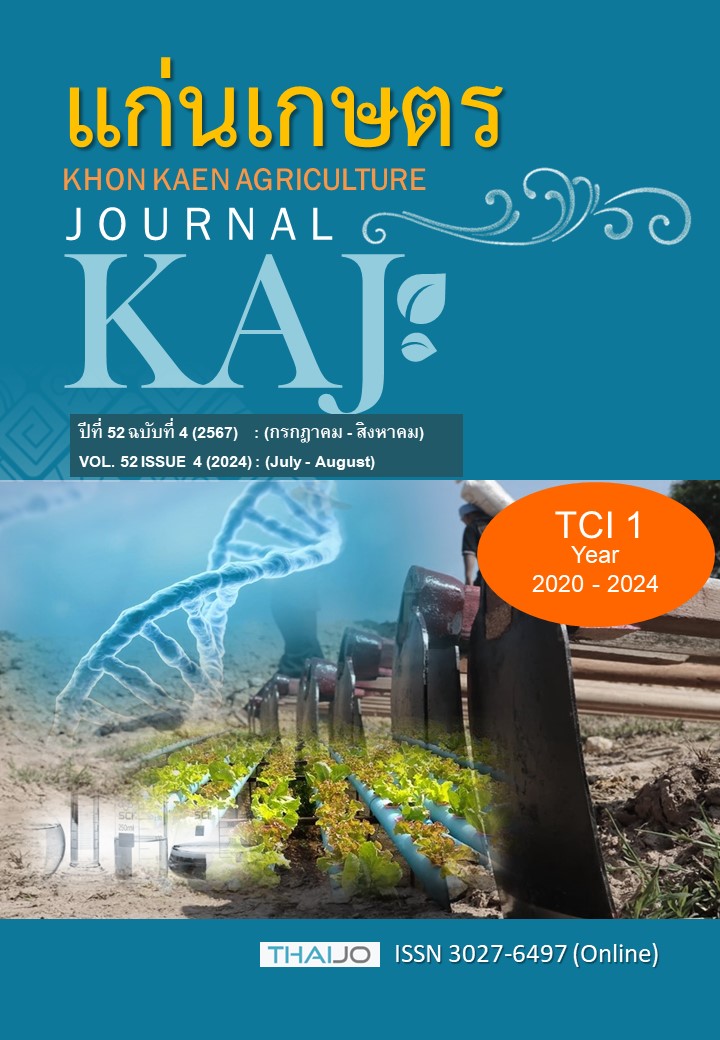ผลของการใช้ถั่วลูปินในอาหารไก่ไข่ต่อสมรรถภาพการผลิตและคุณภาพไข่ช่วงอายุ 22–41 สัปดาห์
Main Article Content
บทคัดย่อ
การศึกษาระดับการใช้ถั่วลูปินในอาหารไก่ไข่ต่อสมรรถภาพการผลิตและคุณภาพไข่ใช้ไก่ไข่พันธุ์ไฮไลน์บราวน์ (Hy-Line Brown) อายุ 22 สัปดาห์จนถึงอายุ 41 สัปดาห์ จำนวน 160 ตัว โดยเลี้ยงบนกรงตับ และมีแผนการทดลองแบบบล็อกสุ่มสมบูรณ์ โดยให้แต่ละแถวเป็นบล็อก แบ่งเป็น 4 กลุ่ม กลุ่มละ 4 ซ้ำ ซ้ำละ 10 ตัว ซึ่งในแต่ละกลุ่มได้รับอาหารที่มีโภชนะต่าง ๆ ใกล้เคียงกัน ดังนี้ 1) กลุ่มที่ไม่ใช้ถั่วลูปิน (กลุ่มควบคุม) 2) กลุ่มที่ใช้ถั่วลูปิน 2% 3) กลุ่มที่ใช้ถั่วลูปิน 4% และ 4) กลุ่มที่ใช้ถั่วลูปิน 6% ผลการทดลองพบว่าการใช้ถั่วลูปิน 4 และ 6% ทำให้ผลผลิตไข่ (% HD) แตกต่างกับกลุ่มควบคุมและกลุ่มที่ใช้ถั่วลูปิน 2% (P < 0.05) และประสิทธิภาพการใช้อาหารดีกว่ากลุ่มควบคุม (P < 0.05) สำหรับคุณภาพไข่ พบว่าน้ำหนักไข่ในกลุ่มที่ใช้ถั่วลูปิน 4% ดีกว่าทุกกลุ่มทดลองแต่ไม่แตกต่างกับกลุ่มที่ใช้ถั่วลูปิน 6% ส่วนการใช้ถั่วลูปินต่อลักษณะของมวลไข่ในกลุ่มที่ใช้ถั่วลูปิน 4 และ 6% ดีกว่ากลุ่มอื่น ๆ (P < 0.01) และกลุ่มที่ใช้ถั่วลูปิน 2, 4 และ 6% ทำให้คะแนนสีของไข่แดงสูงกว่ากลุ่มที่ไม่ใช้ถั่วลูปิน (P < 0.05) ดังนั้นการใช้ถั่วลูปินในอาหารไก่ไข่สามารถใช้ได้ตั้งแต่ที่ระดับ 4% ถึง 6% ในสูตรอาหาร โดยไม่ส่งผลเสียต่อสมรรถภาพการผลิตและคุณภาพไข่ไก่
Article Details

อนุญาตภายใต้เงื่อนไข Creative Commons Attribution-NonCommercial-NoDerivatives 4.0 International License.
เอกสารอ้างอิง
ทองเลียน บัวจูม, สุรีรัตน์ ถือแก้ว และวัชราภรณ์ พิลา. 2566. ผลของกระบวนการให้ความร้อนต่อคุณภาพโภชนะของถั่วพร้าและการใช้ประโยชน์ทดแทนกากถั่วเหลืองในอาหารไก่พื้นเมือง. วิจัยและส่งเสริมวิชาการเกษตร. 40(1): 70–78.
ธนาทิพย์ สุวรรณโสภี. 2564. คู่มือเลี้ยงไก่ในบ้านสร้างเล้าไก่ในฝัน. สำนักพิมพ์บ้านและสวน อมรินทร์พริ้นติ้ง แอนด์พับลิซซิ่ง. กรุงเทพมหานคร.
เยาวมาลย์ ค้าเจริญ. 2565. การใช้สมุนไพรในอาหารสัตว์ไทยมุ่งสู่มาตรฐานอาเซียน. แก่นเกษตร. 41: 369–376.
วิสุทธิ์ พิเพก, โฆษิต ขวาของ, น้ำทิพย์ จิรัฐิติกาลพันธุ์, กังสดาล สมวงษ์อินทร์ และชินทัตน์ นาคะสิงห์. 2562. ผลการศึกษาระดับพลังงานต่าง ๆ ในอาหารที่เหมาะสมต่อสมรรถภาพการผลิตและคุณภาพไข่ในไก่ไข่หลังให้ผลผลิตสูงสุด. แก่นเกษตร. 47(ฉบับพิเศษ 2): 575–580.
ศรีน้อย ชุ่มคำ และอรพินท์ จิตสถาพร. 2560. การเสริมเอนไซม์ย่อยเยื่อใยร่วมกับเอนไซม์ไฟเตสในอาหารไก่ไข่ต่อสมรรถภาพการผลิตและคุณภาพไข่. วิจัยและพัฒนาวไลยอลงกรณ์ในพระบรมราชูปถัมภ์ สาขาวิทยาศาสตร์และเทคโนโลยี. 12(2): 11-17.
สยามรัฐ. 2564. โปรตีนทางเลือก “ถั่วลูปิน” ซุปเปอร์ฟู้ดแห่งอนาคต. แหล่งข้อมูล: https://siamrath.co.th/n/249614. ค้นเมื่อ 18 กุมภาพันธ์, 2566.
อุทัย คันโธ. 2559. อาหารสุกรและสัตว์ปีกเชิงประยุกต์. เรียบเรียงครั้งที่ 1. สำนักพิมพ์ ยูเคที พับลิชชิ่ง จำกัด, กรุงเทพมหานคร.
AOAC International. 2000. Official Methods of Analysis of AOAC International. 17th ed. (Horwitz, W. ed.) AOAC International, Gaithersburg, MD.
Abraham, E. M., I. Ganopoulos, P. Madesis, A. Mavromatis, P. Mylona, I. Nianiou-Obeidat, and D. Vlachostergios. 2019. The use of lupin as a source of protein in animal feeding: Genomic tools and breeding approaches. International Journal of Molecular Sciences. 20 (4): 851.
Alvarez, C., P. Cachaldara, J. Mendez, P. Garcia–Rebollar, and J. C. De–Blas. 2004. Effect of dietary conjugated linoleic acid and fish oil supplementation on performance and egg quality in laying hens. British Poultry Science. 45 (4): 524–529.
Chew, P. G., A. J. Casey, and S. K. Johnson. 2003. Protein quality and physico–function of Australian sweet lupin (Lupinus angustifolius cv. Gungurru) protein concentrates prepared by isoelectric precipitation or ultrafiltration. Food Chemistry. 83: 575–583.
Chung, T. K. 2002. How to get the best out of phytase. Feed Mix. 10: 27–29.
El-Adawy, T. A., E. H. Rahma, A. A. El-Bedawy, and A. F. Gafar. 2001. Nutritional potential and functional properties of sweet and bitter lupin seed protein isolates. Food Chemistry. 74: 455–462.
Francis, G., H. P. S. Makkar, and K. Becker. 2001. Antinutritional factors present in plant-derived alternate fish ingredients and their effects in fish. Aquaculture. 199: 197–227.
Gdala, J., A. J. M Jansman, L. Buraczewska, J. Huisman, and P. V. Leeuwen. 1997. The influence of α–galactosidase supplementation on the ileal digestibility of lupine seed carbohydrates and dietary protein in young pigs. Animal Feed Science and Technology. 67: 115–125.
King, R. H. 1981. Lupin-seed meal (Lupinus albus cv. Hamburg) as a source of protein for growing pigs. Animal Feed Science and Technology. 6: 285–296.
Lee, M. R. F, S. Parkinson, H. R. Fleming, V. J. Theobald, D. K. Leemans, and A. Burgess. 2016. The potential of blue lupins (Lupinus angustifolius), as a protein source, in the diets of laying hens. Veterinary and Animal Science. 1: 29–35.
Rubio, L. A., A. Brenes, I. Setien, G. De La Asuncion, N. Duran, and M. T. Cutuli. 1998. Lactobacilli counts in crop, ileum and caecum of growing broiler chickens fed on practical diets containing whole or dehulled sweet lupin (Lupinus angustifolius) seed meal. British Poultry Science. 39: 354–359.
Safaa, H. M., M. P. Serrano, D. G. Valencia, X. Arbe, E. Jiménez-Moreno, R. Lázaro, and G. G. Mateos. 2008. Effects of the levels of methionine, linoleic acid, and added fat in the diet on productive performance and egg quality of brown laying hens in the late phase of production. Poultry Science. 87: 1595–1602.
SAS Institute Inc. 1989. SAS/STAT User’s Guide. Version 6. Vol.2. (4th 296 ed.). SAS Institute Inc., Cary, N.C.
Shrestha, S., L. V. T. Hag, V. S. Haritos, and S. Dhital. 2021. Lupin proteins: structure, isolation, and application. Trends in Food Science and Technology. 116: 928–939.
Sumiati, R. M., and A. Darmansyah. 2012. Performance of layer hen fed fermented Jatropha Curcas L. meal supplemented with cellulose phytase enzyme. Journal of Indonesian Tropical Animal Agriculture. 37: 108–114.
Talapatra, S. K., B. Talapatra, S. K. Talapatra, and B. Talapatra. 2015. Alkaloids. General Introduction. Chemistry of Plant Natural Products: Stereochemistry, Conformation, Synthesis, Biology, and Medicine. 717-724.


